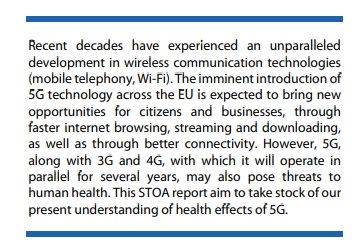

AUTHOR
This study has been written by Dr Fiorella Belpoggi, BSc, PhD, International Academy of Toxicologic Pathology Fellow (IATPF), Ramazzini Institute, Bologna (Italy), at the request of the Panel for the Future of Science and Technology (STOA) and managed by the Scientific Foresight Unit, within the Directorate-General for Parliamentary Research Services (EPRS) of the Secretariat of the European Parliament.
The scoping review search was performed by Dr Daria Sgargi, PhD, Master in Biostatistics, and Dr Andrea Vornoli, PhD in Cancer Research, Ramazzini Institute, Bologna.

Conclusions

Link to the PDF https://www.europarl.europa.eu/RegData/etudes/STUD/2021/690012/EPRS_STU(2021)690012_EN.pdf
ISBN 978-92-846-8030-6 | doi: 10.2861/657478 | QA-09-21-134-EN-N
Excerpt:
7.2 Revising the exposure limits for the public and the environment in order to reduce RF exposures from cell towers
“…one policy option might be to revise residential and public exposure maxima throughout Europe. Levels could be reduced by at least 10 times, i.e. to around 6 V/m, which is an exposure level at which no cancer effects in experimental animals have been observed. 6 V/m seems also to be the precautionary limit where no adverse effects on fertility are concerned. It may sound impracticably low if we are to expand telecommunications by 5G, but it is not so.
In Italy, for example, the law sets a top limit of 20V/m, though wherever people are constantly exposed for over four hours (homes, workplaces, schools, centres of congregation, etc.) the critical value is set at 6 V/m. This limit is very close to the 5 V/m we mentioned before as being safe for experimental animals. NOAEL values (“No Observed Adverse Effect Level”) in experimental studies are commonly used in risk assessments and research (Gaylor, 1999).
In many Italian towns, including Bologna, 5G has already been operating at a frequency of 3600 MHz. Monitoring data show that the mean exposure in the municipality of Bologna was 1.97 V/m for 2019 (peaking at 4.62 V/m in one specific instance). Statistics for 2020 are still being processed, but in no cases have the values prescribed by Italian law been exceeded. For the moment, then, it does seem possible to develop new installations whilst keeping within the legal limit.
Another example is Paris. The city has reached an agreement with France’s four main mobile network operators aimed at introducing stricter network radiation norms. The RF-EMF exposure limit was lowered to 5 V/m from the previous 7 V/m for indoor spaces, representing a 30 percent reduction at the frequency reference of 900 MHz, setting a lower limit than the one adopted in Brussels (6 V/m) or Rome (6 V/m). The agreement, approved by the municipality of Paris in 2017, also includes plans for a new monitoring service to help measure EMF levels within buildings. Brussels is a third example of the adoption of a 6 V/m lower limit.
7.5 Promoting information campaigns on 5G
Unfortunately, there is a lack of information on the potential harms of RF-EMF. The information gap creates scope for deniers as well as alarmists, giving rise to social and political tension in many EU countries (OECD, 2017). Campaigns to inform the citizens should be therefore a priority.
Information campaigns should be carried out at all levels, beginning with schools. They should show the potential health risks, but also the opportunities for digital development, what infrastructural alternatives exist for 5G transmission, the safety measures (exposure limits) taken by the EU and Member States, and the correct use of the mobile phone. Only by sound and accurate information can we win back citizen trust and reach a shared agreement over a technological choice which, if properly managed, can bring great social and economic benefits.
Also see:

Environmental impacts of 5G, a study by Arno Thielens, Ghent University, Belgium, at the request of the Panel for the Future of Science and Technology (STOA) and managed by the Scientific Foresight Unit, within the Directorate-General for Parliamentary Research Services (EPRS) of the Secretariat of the European Parliament.
https://www.europarl.europa.eu/thinktank/en/document.html?reference=EPRS_STU(2021)690021
